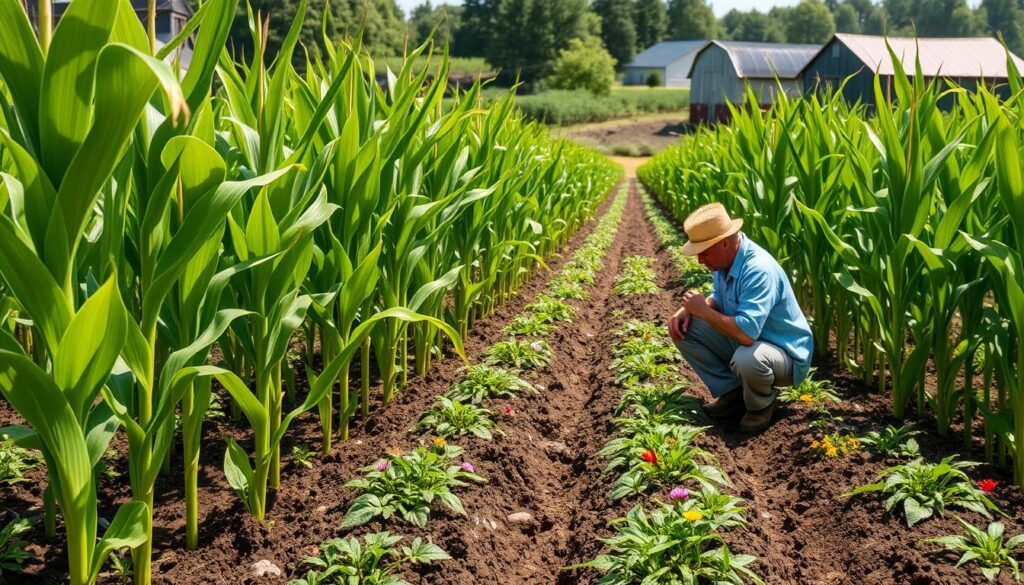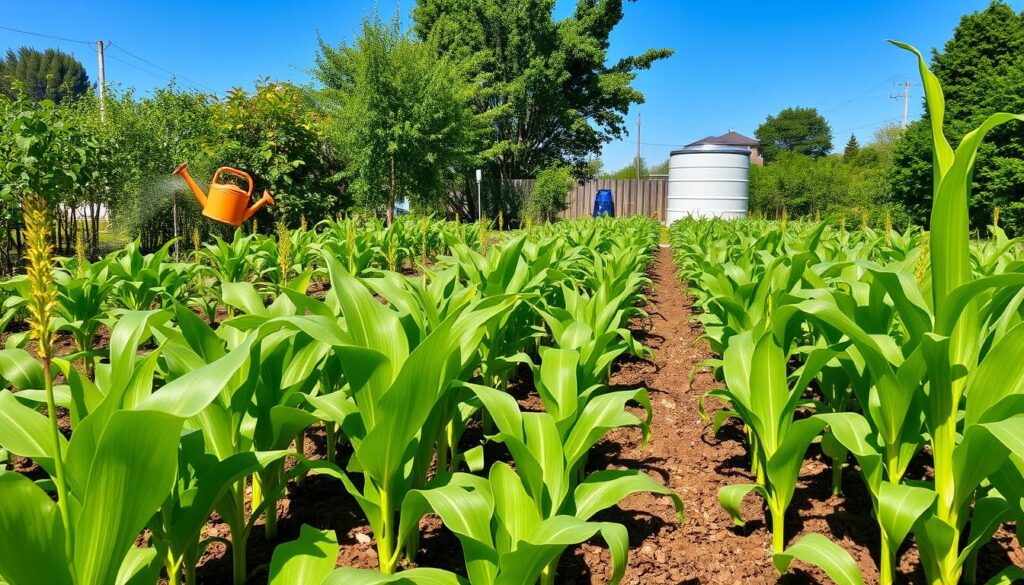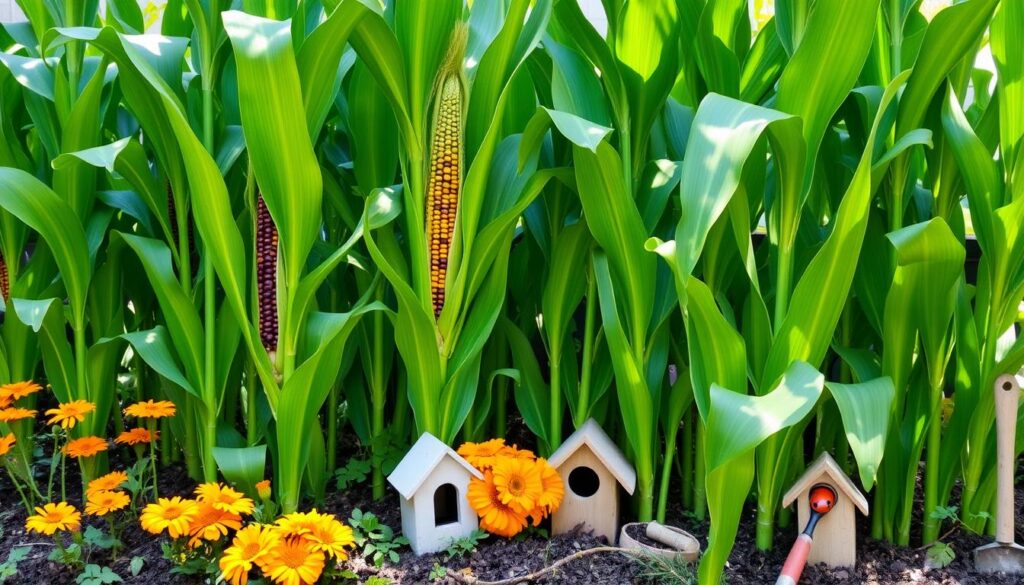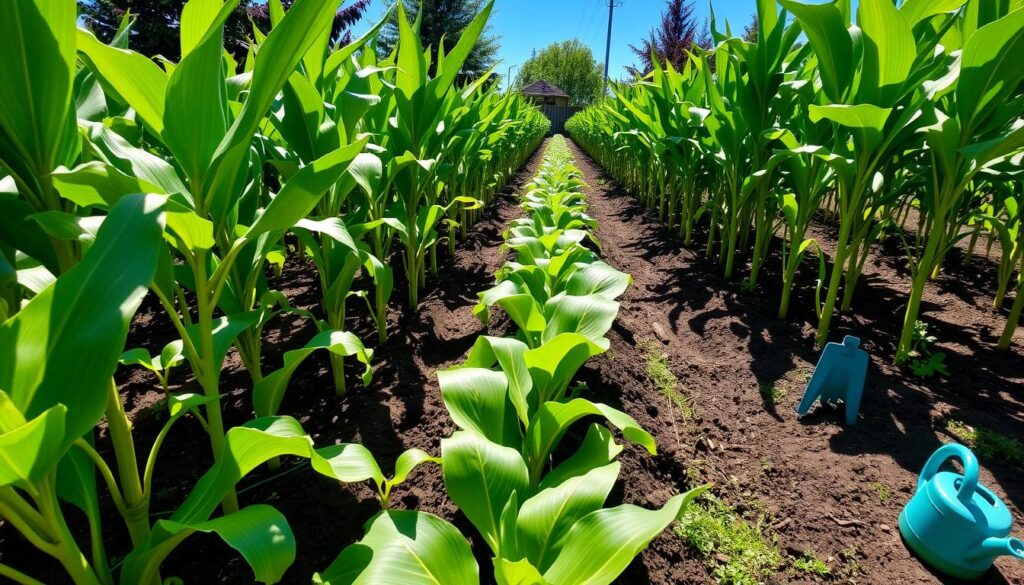Welcome to our guide on growing corn at home. We’ll show you how to grow tasty and healthy corn in your backyard. This guide is perfect for both beginners and experienced gardeners. It will teach you how to grow corn successfully.
Introduction to Corn Growth
We aim to teach you the basics of corn growth. Our guide will help you grow more corn at home. With our tips, you’ll enjoy fresh, home-grown corn.
Key Takeaways
- Learn how to grow corn at home with our step-by-step guide
- Understand the importance of choosing the right corn variety for your climate
- Discover the essential growing requirements for successful corn growth
- Get tips on how to maximize your corn yield using our corn cultivation tips
- Learn about common mistakes to avoid when growing corn at home and how to grow corn
- Find out how to harvest and store your home-grown corn using our corn planting guide
- Get started with growing corn at home and enjoy the benefits of fresh, home-grown corn and learn how to grow corn
Understanding Corn Varieties for Home Gardens
Choosing the right corn variety is key for a good harvest. There are many types of corn, each with its own traits. Knowing these differences helps you pick the best one for your garden.
Sweet corn is a favorite for home gardens. But field corn is great for animal feed or other uses. Your choice depends on your needs and your area’s climate. Early season varieties work well in short seasons, while late season ones are better for longer seasons.
Sweet Corn vs. Field Corn
Sweet corn is picked when its kernels are soft and milky. Field corn is picked when its kernels are dry and hard. Sweet corn is sweeter and eaten fresh, while field corn is used for animal feed and other industrial uses. Both can be grown using organic methods for a sustainable garden.
Early Season Varieties
Early season varieties are perfect for short seasons. They mature fast, in about 60-70 days, and handle cooler weather well. They’re great for gardeners who want to beat the first frost.
Late Season Varieties
Late season varieties are best for longer seasons. They take 90-100 days to mature and can handle heat and drought. They’re perfect for late summer or early fall harvests.
By knowing the different corn varieties and using the right growing techniques, you can have a successful harvest. Whether you grow sweet corn or field corn, organic farming methods make your crop healthier and more sustainable.
Essential Growing Requirements for Successful Corn Growth
To grow corn well, you need to give it the right conditions. This means full sun, well-drained soil, and enough water. Corn also needs a balanced fertilizer to grow strong and healthy. By following these tips, you can make a great place for your corn to grow.
Some important things to think about when growing corn include:
- Soil quality: Corn likes well-drained, fertile soil with a pH between 6.0 and 7.0.
- Watering: Corn needs about 1 inch of water per week, either from rain or irrigation.
- Fertilization: A balanced fertilizer with a ratio of 10-10-10 (nitrogen-phosphorus-potassium) helps with growth.
By knowing and using these key growing needs, you can have a successful harvest. Maximizing corn yield means paying close attention and making sure your plants have the best conditions.
Selecting and Preparing Your Garden Space
Choosing the right garden space is key for growing corn. Corn needs full sun, at least six hours a day. Before planting, test your soil’s pH level. It should be between 6.0 and 7.0 for the best growth.
To get your garden ready, think about these points:
- Soil quality: Corn likes well-draining, fertile soil with a pH between 6.0 and 7.0.
- Space planning: Plant corn in blocks, not long rows. This helps with pollination and protects against wind.
- Sunlight needs: Pick a spot with full sun, as corn needs at least six hours of direct sunlight daily.
By following these tips and considering your garden’s needs, you can create a perfect spot for corn. Always test your soil and adjust your garden layout as needed for a great harvest.
| Factor | Optimal Condition |
|---|---|
| Soil pH | Between 6.0 and 7.0 |
| Sunlight | At least six hours of direct sunlight per day |
| Space Planning | Plant in blocks, not long rows |
How to Grow Corn: Basic Steps and Techniques
Growing corn can be very rewarding. It’s best to follow a corn planting guide and use organic corn farming methods. First, you need to prepare the soil, plant the seeds, and take care of them.
A good gardening guide offers helpful tips for growing corn. It’s important to pick the right corn variety, add organic matter to the soil, and ensure it gets enough sunlight and water.
Here are some basic steps to follow when growing corn:
- Prepare the soil by adding organic matter and removing any debris
- Plant the seeds about 1 inch deep and 6 inches apart
- Water the soil regularly, but avoid overwatering
- Provide support for the corn stalks as they grow

By following these steps and using organic corn farming methods, you can enjoy a big harvest of tasty and healthy corn. Always follow a corn planting guide and take the right steps for a successful crop.
Timing Your Corn Planting
Timing is key when growing corn. Planting at the right time can greatly increase your yield. Spring is usually the best time, when the soil is warm and frost risk is low.
To find the perfect planting time, look at soil temperature, moisture, and the last frost date. Regional considerations are also important. For example, in short seasons, plant as soon as the soil is ready in spring.
Spring Planting Guidelines
Wait until the soil hits 55°F (13°C) for spring planting. This is often late April or early May. Plant seeds 1 inch deep and 6-8 inches apart, in rows 3 feet apart.
Succession Planting Methods
Succession planting can boost your corn yield. Plant small batches every 1-2 weeks. This method extends harvest and lowers crop failure risk.
Regional Considerations
Climate and soil type greatly affect corn growth. In wet areas, plant on raised beds for better drainage. For dry areas, choose drought-resistant varieties.
| Region | Optimal Planting Time | Soil Temperature |
|---|---|---|
| Northern States | Late May | 60°F (15°C) |
| Southern States | Early April | 65°F (18°C) |
| Western States | Mid-April | 55°F (13°C) |
Soil Preparation and Fertilization Methods
For a successful corn crop, focus on best practices for growing corn. This includes soil preparation and fertilization. Organic corn farming methods are great for a healthy soil environment. Use natural fertilizers like compost or manure to enrich the soil.
Some key considerations for soil preparation and fertilization include:
- Soil testing to determine nutrient levels and pH
- Adding organic matter, such as compost or well-rotted manure, to improve soil structure and fertility
- Using natural fertilizers, such as fish emulsion or bone meal, to provide essential nutrients
By following these best practices for growing corn and adopting organic corn farming methods, you can create a thriving and sustainable corn crop. Always prioritize soil health and use natural, environmentally friendly methods whenever possible.

With proper soil preparation and fertilization, you’ll be well on your way to growing a healthy and productive corn crop. Happy farming!
| Soil Preparation Method | Description |
|---|---|
| Composting | Adding organic matter to improve soil structure and fertility |
| Manure Application | Using natural fertilizers to provide essential nutrients |
| Soil Testing | Determining nutrient levels and pH to inform fertilization decisions |
Planting Corn Seeds Properly
When growing corn for beginners, planting seeds right is key. To get a good harvest, follow some important tips. One major thing is to space rows and plants correctly. This helps with growth, air flow, and sunlight.
Here are some guidelines to keep in mind:
- Plant seeds about 1 inch deep and 6-8 inches apart in rows that are 3 feet apart.
- Use block planting techniques to plant seeds in a grid pattern, which helps to improve pollination and reduce waste.
- Make sure the soil is warm and well-draining before planting, as corn seeds are sensitive to cold and wet conditions.
By following these tips, you’ll grow healthy corn plants. For more gardening advice, check out gardening resources.
Proper planting techniques are just the start. With the right care, your corn will grow well. Stay tuned for more tips on growing corn and veggies.
Watering Techniques for Healthy Corn Growth
Proper watering is key for corn growth. It affects the health and yield of the crop. Corn needs about 1 inch of water each week, from rain or irrigation.
To save water and cut down on evaporation, use drip irrigation or soaker hoses. These methods send water straight to the roots. This cuts down on runoff and evaporation. Also, mulching around plants keeps soil moist and stops weeds.

- Water deeply and infrequently to encourage deep root growth
- Avoid overhead watering, which can lead to fungal diseases
- Use a rain gauge to measure rainfall and adjust irrigation according
By using these watering methods and other techniques like crop rotation, you can boost corn yield. Enjoy a healthy and productive harvest.
Supporting Your Growing Corn Plants
As your corn plants grow, they need support to avoid falling over in the wind. This is key in best practices for growing corn. It keeps your plants upright and healthy. In organic corn farming, natural methods are better than synthetic ones.
To support your plants, use bamboo stakes or tomato cages. Place them around the plants and tie them gently with twine or clips. This keeps your corn plants steady, even when it’s windy.
Staking Methods
- Use bamboo stakes, which are sturdy and biodegradable
- Utilize tomato cages, which can be easily placed around the plants
- Tie the plants to the stakes using twine or clips, taking care not to damage the stems
Wind Protection
For extra wind protection, plant your corn in a block, not rows. This reduces wind damage. You can also use natural windbreaks like burlap or snow fencing to shield your plants.
By following these tips and using best practices for growing corn, your plants will stay healthy and grow well, even in windy weather. Always choose organic corn farming methods for a better environment and healthier plants.
Natural Pest Control Strategies
When growing corn, pests can be a big problem. But, there are many natural ways to keep them away. As a beginner, learning these strategies is key to a healthy harvest. It’s all about paying attention to the little things, like using natural pest control.
Common pests like aphids, earworms, and cutworms can harm your corn. To fight them, try organic solutions like neem oil, insecticidal soap, and diatomaceous earth. These methods are good at keeping pests away and work well with other tips for growing corn.
Common Corn Pests
- Aphids: small, soft-bodied insects that feed on plant sap
- Earworms: larvae of moths that feed on corn kernels
- Cutworms: larvae of moths that feed on plant stems
Organic Solutions
Here are some effective organic pest control options:
- Neem oil: a natural insecticide that disrupts pest hormone systems
- Insecticidal soap: a mild dish soap that can be used to control soft-bodied pests
- Diatomaceous earth: a powder made from fossilized algae that dehydrates and kills pests

Preventive Measures
To stop pests before they start, use a mix of tips. Crop rotation, keeping things clean, and using biological control are all helpful. These steps can lower the chance of pests and help your corn grow well.
| Pest | Organic Solution | Preventive Measure |
|---|---|---|
| Aphids | Neem oil | Crop rotation |
| Earworms | Insecticidal soap | Sanitation |
| Cutworms | Diatomaceous earth | Biological control |
Disease Prevention and Management
Preventing disease is key to growing more corn. Corn can get sick with rust and smut, hurting yield and quality. Keeping the farm clean, removing sick plants, and rotating crops are important steps.
Here are some ways to stop diseases:
- Choose corn that’s resistant to diseases
- Use fungicides when needed
- Make sure air and soil can drain well
These steps help lower disease risk and boost corn yield. Watching your corn closely is also vital. This way, you can catch diseases early and stop them from spreading.
Also, a healthy soil helps prevent disease. Use organic stuff and no-till farming to keep the soil right. This creates a great place for corn to grow, leading to better yields and less disease.
Pollination Tips for Better Yield
Pollination is key in corn production. Using the best practices for growing corn can really boost yields. Organic farming focuses on natural pollination to improve both quality and quantity of crops.
Hand Pollination Techniques
Hand pollination means moving pollen from the tassel to the corn ear by hand. It’s great for small farmers or gardeners who want to ensure their corn is well-pollinated. Use a small, clean brush and do it in the early morning when pollen is most active.
Improving Natural Pollination
To get better natural pollination, plant corn in blocks, not rows. This helps pollen move between plants more easily. Also, planting flowers that attract bees and butterflies can help pollination. By following these tips, farmers can grow more and better organic corn.
Companion Planting with Corn
Companion planting is a key aspect of growing corn. It involves planting different crops together to enhance their growth. For beginners, knowing which plants to pair with corn is vital for a good yield.
Beans and squash are great companions for corn. They help each other grow and improve the soil. Beans fix nitrogen, which helps corn. Squash spreads its leaves to keep weeds away and hold moisture.
Beneficial Companion Plants
- Beans: fix nitrogen in the soil, reducing the need for fertilizers
- Squash: provides shade, prevents weeds, and retains moisture in the soil
- Cucumbers: can be trained to climb up corn stalks, making the most of space
Plants to Avoid
Some plants don’t do well with corn. Tomatoes and potatoes are examples. They can attract pests or spread disease to corn.
By choosing the right plants, growers can create a healthy garden. Companion planting is a simple way to boost corn’s health and yield. It’s a key skill for beginners to master.
Harvesting Your Home-Grown Corn
As you near the end of your corn growing journey, it’s essential to understand the best practices for harvesting your home-grown corn. This final step is key to getting the most out of your crop. By using the right techniques, you can ensure a great harvest.
To know when to harvest, check the moisture and kernel development of your corn. Timing is everything for harvesting corn. It greatly affects the quality and yield of your crop. Here are some important factors to consider:
- Check for moisture levels: Corn is ready when the kernels are fully mature and the moisture is between 20-25%.
- Inspect kernel development: The kernels should be fully formed and filled with a milky liquid.
When your corn is ready, use the right harvesting techniques to avoid damage. Use a sharp knife or pruning shears to cut the stalks, leaving about an inch of stem attached to the ear. After harvesting, store your corn in a cool, dry place to keep it fresh.
Storage Methods
To keep your harvested corn fresh, consider these storage methods:
- Refrigerate: Store corn in the refrigerator at a temperature of 40°F (4°C) or below.
- Freeze: Blanch and freeze corn to preserve its flavor and texture.
By following these tips and using the right techniques, you can enjoy a successful harvest and maximize your corn yield.
Troubleshooting Common Growing Problems
Even with careful planning, growing corn can face challenges. Common issues include pests, diseases, and nutrient deficiencies. Identifying the cause is key to solving these problems. For instance, pests can be managed with organic methods like introducing beneficial insects or using natural pest control.
Practices like crop rotation help prevent pests and diseases in the soil. Organic farming, including compost and manure, promotes healthy soil. These methods reduce the need for synthetic fertilizers. By adopting these practices, you can lower the risk of common problems and enjoy a bountiful harvest.
Here are some tips for troubleshooting common growing problems:
- Monitor your plants regularly for signs of pests or diseases
- Use organic methods to control pests and diseases
- Ensure good soil health through crop rotation and the use of natural fertilizers
By following these tips and using organic farming methods, you can overcome common growing problems. This approach promotes healthy soil and reduces the need for synthetic fertilizers. Remember, a successful harvest is within reach with the right practices.
| Common Growing Problems | Causes | Solutions |
|---|---|---|
| Pests | Presence of beneficial insects | Introduce beneficial insects, use natural pest control products |
| Diseases | Poor soil health, excessive moisture | Improve soil health, ensure good drainage |
| Nutrient deficiencies | Lack of essential nutrients | Use natural fertilizers, ensure good soil health |
Saving Seeds for Next Season
When growing corn, saving seeds is a smart move. It helps you have a steady supply for future seasons. This is key for beginners to keep their seeds quality and alive.
To begin, pick the best seeds from your crop. Choose seeds that are fully dry and mature. They should have the best chance to grow well. Also, look at the seed’s size, shape, and color to judge its quality.
After picking your seeds, it’s important to store them right. Here are some tips for keeping them fresh:
- Store seeds in a cool, dry place, like a basement or cupboard.
- Use airtight containers, such as glass jars or plastic bags, to keep seeds fresh.
- Keep seeds away from direct sunlight and moisture.
By following these tips and storing seeds well, you’ll have a great harvest for years. Always handle your seeds carefully. Keep them in a safe place to keep them viable.
Conclusion
We hope this guide on growing corn at home has inspired you. You now have the knowledge to grow delicious corn at home. Whether you’re new to gardening or have experience, growing your own corn is incredibly rewarding.
Growing corn takes patience and care, but it’s worth it. Follow our steps, choose the right corn, and use good gardening tips. You’ll enjoy fresh, tasty corn from your garden. Don’t be afraid to try new things and ask for help from gardening groups.
As you start growing corn, we wish you lots of success. Enjoy the process, celebrate your harvests, and share your corn with loved ones. Happy gardening!
FAQ
What are the different varieties of corn for home gardens?
Home gardens can grow two main types of corn: sweet corn and field corn. Sweet corn is loved for its taste. Field corn is better for animal feed. There are also early and late season varieties, each suited for different climates.
What are the essential growing requirements for corn?
Corn needs full sun, well-drained soil, and enough water to grow well. It’s a heavy feeder, so a balanced fertilizer is key to its health.
How do I select and prepare the garden space for growing corn?
Choose a spot that gets full sun and has good drainage. Test your soil’s pH and adjust it if needed. Plan your layout for proper spacing between plants and rows.
What are the basic steps for growing corn?
Growing corn involves planting seeds, watering, fertilizing, and supporting the plants. Watch out for pests and diseases to keep your crop healthy.
When is the best time to plant corn?
Plant corn in the spring after the last frost. Succession planting can extend your harvest.
How do I prepare and fertilize the soil for corn?
Prepare the soil by tilling and adding organic matter or compost. Use a fertilizer rich in nitrogen, phosphorus, and potassium for corn’s needs.
How do I properly plant corn seeds?
Plant seeds 1-2 inches deep and 8-12 inches apart. Rows should be 2-3 feet apart. Block planting helps with pollination.
How do I water and support my growing corn plants?
Keep the soil moist, using drip irrigation or sprinklers. Support the plants with stakes or cages as they grow.
How do I manage pests and diseases in my corn crop?
Use organic methods like beneficial insects or neem oil to control pests. Watch for diseases like rust and smut, and prevent outbreaks.
How do I know when to harvest my corn?
Harvest corn when kernels are plump and silk is brown. Check by peeling back the husk. Harvest at peak ripeness.
How do I save seeds from my corn crop for next season?
Save seeds from the best cobs after they dry. Remove kernels and store in a cool, dry place for next year’s planting.
Share this post: on Twitter on Facebook

